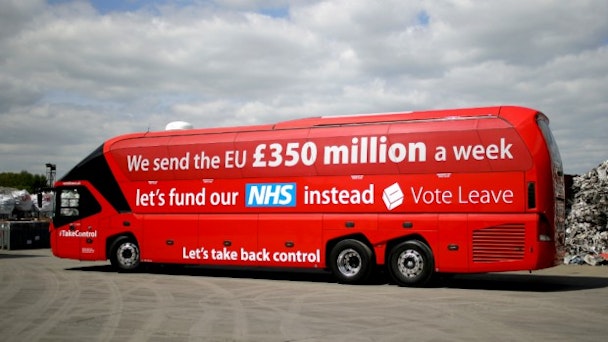Copywriting of the Year (sadly)
Few misconceptions cause quite so much froth as the criteria for Time’s ‘Person of the Year’ award.

Since its inception in 1927 it’s been handed out to, amongst many others, Adolf Hitler, Joseph Stalin and Vladimir Putin. Donald Trump – though yet to achieve anything more historically barbaric than peculiar hair and a tendency toward stumpy-fingered grabbiness – joins that chorus of villainy as this year’s recipient.
Yet the award has always been to mark the individual who ‘for better or for worse has done the most to influence the events of the year’.
So, in this same spirit, I’ve decided to recognise the 'copy of the year' – not for its creative brilliance, but for its starring role in the biggest, most discordant conversation of the year.
That piece of copywriting was emblazoned on a large red ‘battle bus’ and told an increasingly divided Britain that ‘We send the EU £350 million a week. Let’s fund our NHS instead’.
There’s no point in dwelling on either the result of that particular political scuffle, or the dissection of that headline. It’s sufficient to say that the Leave campaign’s champagne had barely lost a bubble of fizz by the time Nigel Farage appeared on national television to disown the pledge entirely.
‘That was one of the mistakes that I think the Leave campaign made’ he explained, while an already snarling Twitter erupted in a howl that is yet to subside.
So a great deal of the fury, acrimony, smugness and despair (Twitter’s four primary food groups) expended this year has all come from a piece of copywriting.
Unsurprisingly, I doubt many of us in the profession are filled with pride at such an achievement. But many of the writers I’ve discussed this with, putting aside their political chompings, are mostly annoyed at how easily a demonstrably false headline went to print.
Copywriters are, quite rightly, challenged every day on not only the empirical accuracy of our claims but on the subjective honesty of them as well. Wilfully wording a headline so that it is misunderstood is perhaps an even grubbier copywriting offence than writing an outright lie.
The curious thing from a copywriter’s point of view is how potent this one, openly hysterical headline seemed to be. A poll by Ipsos MORI revealed that over half of the population believed it to be true.
The most extraordinary thing is that the headline had even been openly challenged at the time, by credible sources – namely the UK Statistics Authority on more than one occasion. So it’s not as if the opportunities to question the legitimacy of those words hadn’t been out there amongst the debate already.
Seemingly, that carefully worded headline tapped perfectly into a rampant confirmation bias – putting a number, and an injustice, to the hazy concept that the EU gobbles up our public money like it was made of bratwurst and croissants.
More worryingly, for anyone who makes a living from communication, persuasion and earning trust, it’s also symptomatic of some sinister new ideologies with such appallingly Orwellian names as ‘post-truth’. And I don’t even care to think how copywriting (or indeed humanity) may look in a world that has no time for experts.
So, even though there have been some fabulous, memorable examples of copywriting this year, the one that can boast the greatest success is a suspicious headline plastered on the side of one very divisive bus.
Incidentally, that bus has now been acquired by Greenpeace who have decorated it with their own slogans: ‘Time for Truth’ and ‘#ComeClean’.
Sadly, I doubt their impact will be quite so dramatic.
Follow Andrew on Twitter
